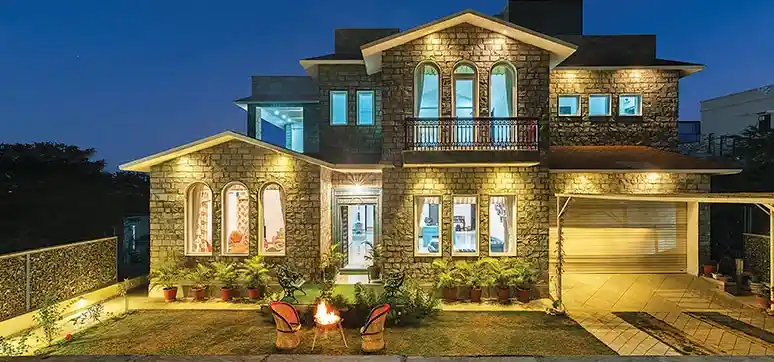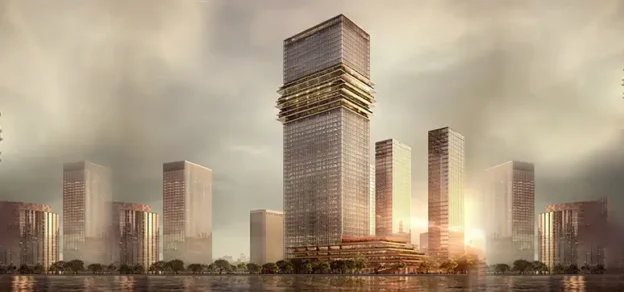A sustainable home in India should allow the Indian way of living in the current scenario. It should provide comfortable living conditions of yesteryears haveli’s, yet look contemporary. We used to have bungalows with lush green envelopes, where an old fan was sufficient to gauze summer heat. Try designing a space where air conditioning is not a year-round necessity.
The planning principles of inducing desirable microclimates can be combined with modern construction techniques to create smarter homes. Rather than blindly following what is happening in the world, we should see our environment and social needs as a parameter to design living units.
Few techniques that we are trying to revive include stone and lime construction. These buildings withstand time and climate beautifully. They are breathable, living surfaces that combine to make a responsive space.
Most sustainable techniques are taught to us in schools, like the size of windows in different directions, or the length of sunshades. All we have to do is to use the knowledge wisely. The checklists from IGBC are a great help in checking all parameters. Although currently there is no standard rating system, we have used the pointers extensively. To obtain an ecologically high-performance building, multiple variables should be taken into consideration – thermal insulation, daylighting, solar shading, glare acoustics, and indoor air quality.
Another element that we use in all homes is a courtyard or skylight. They bring light to dark corners and aid in natural ventilation. Currently, we are working on using geothermal energy and solar energy to create homes that can function off-grid. Seems like these buildings are the future of smart homes, where the occupant can live carbon neutral.
Suggestions for sustainable planning-
• Every space should be naturally lit, but glare-free
• Cross-ventilation to allow a breeze
• Water-coolers for larger areas, to reduce energy consumption. This allows for fresh air, as spaces do not have to be air-locked
• Composite-wall system for better insulation, finishing, and longevity
• Go local
• Efficient space planning
• Use natural resources, solar energy, bio-digester tanks
• Live as our parents did, prudent and wise. They saved resources for us, it is our responsibility to leave this planet well for future generations.

Residence 58 Udaipur, Rajasthan
The bungalow is located at the foothills of Aravali mountains, overlooking Goverdhan Sagar Lake. The scenic surroundings demanded the country look. The clients approached us with a picture of their ‘dream home’ in their hands and the urgency to complete it. Demands were clear; we went on to work it out.
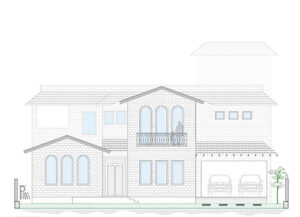
This story began with a quest to create the perfect dream home at the foothills of Aravali Hills with a scenic Lake view. Owing to the hot and dry climate of Rajasthan, choosing a central courtyard to plan things around was a good start. The aim was to get thermal comfort in either of the seasons without using mechanical means to achieve a sustainable space in terms of energy consumption. The house should stay cool during summers and warm during winters.
Spatially, internal spaces merge into one another on both floors. External terraces abutting each room create private space for the individuals. The house is seamless in planning and the decor is uniform Rajasthani style. The matrix of private and semi-private spaces is created in a way that volume and scale strike a balance, resulting in each space complimenting the other. The flavor of Rajasthan in motifs and color is reflected in the details.
Composite Wall System
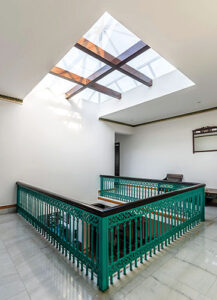
hot and dry climate of Rajasthan and allows light, ventilation, and communication with the upper floor
In this project, the built system highlights using a composite wall system; showcasing the amalgamation of design and technology in the contemporary realm. We undertook this challenge and it worked.
The exterior aggrandizes the beauty of the surroundings, whilst internal planning follows passive climate control and function. The central courtyard suits the hot and dry climate of Rajasthan and allows light, ventilation, and communication with the upper floor. Exterior has composite stone wall proving as good insulator, solar power, and bio-digester tank makes it a sustainable abode.
The approach of designing a double skin façade prevents thermal energy loss in buildings. An efficient approach included handling thermal energy waste/ loss efficiently, use of solar power, reduction in consumption of power for heating and cooling, good façade sound insulation, and protection against pollution.
Conventional framed structure is modified to have a stone and brick composite wall. This facilitates thermal insulation from the exterior and integration of electrical services in interiors. Design is such that RCC beams and columns are enveloped in stone on the outside and brick on the inside. Special details are made for door and window openings. Several samples were made for various joints and corners to ascertain proper stone masonry. This works two ways, ensuring aesthetics and climate control. The exterior wall is 6 inches thick stone from Chittor, and every stone was manually cut by local craftsmen on site.
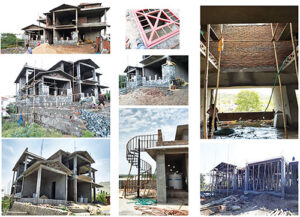
This stone is a great insulator and resistant to the effects of rain and weather. There is no need for painting, coating, or any maintenance. Since the time, it has been long proven that incorporation of local materials within the built results in a green or sustainable building. Even the smallest pieces of stone were used in building the gabion wall for a boundary. Local materials help in easier handling for local craftsmen reducing the execution time while benefitting structurally and aesthetically.
The outside provides a fitting foreground to this splendid house. A variety of plants, cactuses, and vegetables grow there. The vines and trees are yet to grow and add to the landscape. Upon entry, the front lawn, flanked by a gabion wall is a social space where bonfires are done and barbeque aroma floats. It is made with minimum metal and similar color stones are fixed in.
Fenestrations
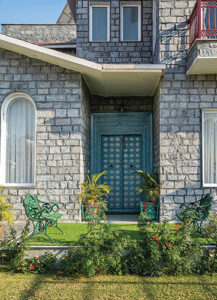
Smaller openings are given towards western and southern façades, reducing heat gain and glare, whilst big picture windows are provided in the north direction. The dining area has a big picture window touching the ceiling, no beam there too. Big picture windows on the north side accentuate the life to the next level, as more natural light washes the floors and ceilings. Everywhere one sees, there is something to gaze upon.
Spatially, all spaces open to the central courtyard, which has natural light through the day, and stars can be seen through at night. The house is seamless in planning and uniform culturally rich decor is done. The matrix of private and semi-private spaces is created in a way that volume and scale strike a balance, resulting in each space complimenting the other. The central courtyard is an integral part of all residences as it gives a central void space, the shunya, with light entering from the top. This also creates vertical airflow in hot and dry regions. Small openings are kept at the top for venting out hot air. This is a sustainable home with style and contribution to the environment.
In the client’s own words, they are enjoying the home very much and it is exactly as they wanted it to be! There is no need for artificial light till sunset. During summers, they rarely use air-conditioners and winters are comfortable. It’s peaceful, serene with retreat vibes yet connected with the hustle around.
QUICK FACTS:
Project: Residence 58
Location: Udaipur, Rajasthan
Client: Mr. GS Jhala Principal
Architect: Ar. Priyanka Arjun
Design Team: Priyanka Arjun, Shaunak Singh, Rida Rafi, Shailesh Rawal
Civil Contractor: Mr Narayan Singh
Structural Consultant: Mr BP Joshi
Façade Engineering: Shingles – Kitmart, Fabrication – Mr BP Joshi
Brand/Product Details:
Tiles – Bikaner Tiles;
Plywood – Green Ply;
Marble – Nijarna White Marble, Indian Onyx Marble
Fenestration – Veka
Build Area: 7270 Sqft
Site Area: 5400 Sqft
Year of Commencement: January 2016
Year of Completion: September 2018
Project Cost: 1 CR.
Photography: Raghu Raj Singh
